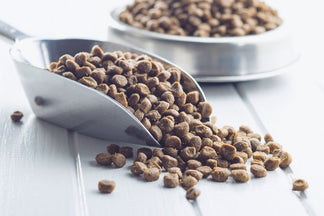It has been well established that dogs and cats need a diet high in protein and with adequate fat. But what about carbohydrates- is this macro-nutrient essential to a pet’s diet? To answer this question, let’s first discuss the role of carbohydrates and then look at what the canine and feline ancestral diets might have looked like.
The Role of Carbohydrates
Carbohydrates can provide several benefits as a macro-nutrient including:
Provide Energy –although dogs and cats are able to convert protein and fat to satisfy their energy requirements, carbohydrates are a relatively inexpensive and practical way to provide adequate energy for your pet.
Provide Beneficial Fiber - carbohydrates are the source of dietary fiber, which promotes overall gastrointestinal health by increasing gastrointestinal motility and by collecting debris and dead cells that accumulate in the gastrointestinal tract. Soluble fibers, sometimes called prebiotics, aid in promoting the growth of additional beneficial (or probiotic) bacteria and helps crowd out pathogenic (disease-producing) bacteria.
Creates Satiation - carbohydrates (and their associated fiber) helps the pet feel satiated and thus, ‘less hungry’.
The Canine and Feline Ancestral Diet
According to Steve Brown, author of the “Unlocking the Canine Ancestral Diet”, carbohydrates played a minimal role in the dog’s ancestral diet—less than 10% of the marco nutrient profile. This is far less than most commercially available foods, with many dry foods containing between 30% and 70% carbohydrates.
Does this mean that carbohydrates are inherently bad for your dog? No, as long as they are not a major source of energy when compared to protein and fat, carbohydrates can provide the aforementioned benefits to your dog.
The natural diet of feral cats, which closely mimics that of their ancestors, consists primarily of small mammals, birds, fish, reptiles and invertebrates. The macronutrient concentration of the feral cat diet consists primarily of protein and fat with little carbohydrate.
Research conducted at The Waltham Centre for Pet Nutrition has identified a preferred macronutrient profile (relative amounts of protein, fat and carbohydrate) for cat diets. The data shows that cats should obtain about 50% of their calories from protein, 40% from fat and 10% from carbohydrate.
Normal dog and cat bodies therefore are meant to thrive on high protein, low carbohydrate foods.
Sources of Carbs
There is a variety of common sources of carbohydrates in commercially available pet food. Look for higher quality carbohydrate sources like these listed below:
- oats
- barley
- millet
- sorghum
- sweet potatoes
- peas
- chick peas
We also recommend avoiding lower quality sources such as:
- grain by-products
- middlings
- mill run
- cereal food
- grain fermentation solubles
- starch
- gluten
Unfortunately, most pet foods do not report the amount of carbohydrates on the food package. In order to determine the relative amounts of protein, fat, and carbs, you will need to calculate the dry matter basis. You can learn how to do that here.
References:
http://www.petmd.com/dog/nutrition/evr_dg_carbohydrates_key_to_balanced_dog_food
http://www.peteducation.com/article.cfm?c=1+2244&aid=2641
http://www.nutro.com/pet-care-professionals/veterinarians/nutro-pet-nutrition-desk-reference.pdf



 Food
Food
 Food
Food
 Food
Food
